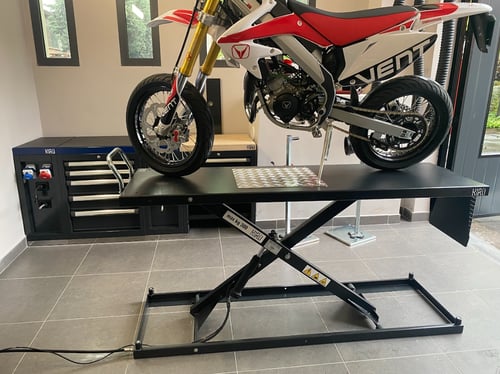 Making the choice of a motorcycle lift table to incorporate into your workshop can often be considered obvious, without however taking into consideration either the construction of the lift itself or the design aspects of the space where it will be installed.
Making the choice of a motorcycle lift table to incorporate into your workshop can often be considered obvious, without however taking into consideration either the construction of the lift itself or the design aspects of the space where it will be installed.
The design phase plays a key role in reaching maximum efficiency and creating a safe and functional work environment for mechanics.
Keep reading to find out all the details for effectively incorporating a new lift table into your workshop.
Identifying the Features of the Ideal Motorcycle Lift Table
Vehicle lifts are not all created equal.
That's why it’s important to be very clear on your requirements before choosing a new motorcycle lift table.
But where to start with this analysis?
Concrete day-to-day experience, the reality that mechanics experience in the workshop every day, is the most solid starting point for identifying the most suitable lift table.
On the basis of the information gathered, you can move on to the search for your lift, choosing between:
- Lift tables with various minimum heights from ground when closed
- Lift tables with various maximum heights when fully open
- Lifts with or without front and rear hatches
- Lifts with or without retractable/tilting ramp
- Lifts driven by pump or via an electrohydraulic power unit
Each of these elements has a different effect on the mechanics’ work, making it more or less efficient with consequent effects on the workshop's revenue and profitability.
The goal is to find a lift which makes the mechanics’ work easier and more efficient: this will mean that even spending a bit more on a lift table will be an effective long-term investment.
Finding the Most Suitable Space for the Motorcycle Lift Table
As mentioned at the beginning of the article, the planning phase for the workshop layout is nowadays taking on an ever-more central role.
Those taking the decision to build a new workshop or modernise an existing one should put their trust in an expert able to make the necessary recommendations and accompany them through the design stage, in order to get the most out of it and increase the efficiency.

During the design phase, identifying the best position for the lift is key.
Here are some examples.
Depending on the configuration and the flooring used in the workshop, you may or may not decide on a recessed installation for the lift table.
A recessed lift avoids differences in level which are dangerous when loading and unloading the vehicle, decreasing the risk of accidents and the potential for damage to the bike.
It is not always possible to carry out the excavations required for this however, and in these cases choosing a lift with a very small minimum height when closed can help achieve a result very close to that of a recessed lift.
Another very important element to take into consideration is how close the lift is to the workbenches.
The closer the lift is to the workbenches, the shorter the distance between the mechanic and the tools they require to carry out the work.
This both saves time and increases productivity.
Moreover, having a lift table equipped with hatches near a suspension workstation can be the turning point for carrying out more precise maintenance, with less oil spread around the area and without the need to offload the vehicle from the lift multiple times during the process.
Starting out from strategic positioning of the motorcycle lift table, it is then possible to continue to develop an efficient configuration for all the available space in the workshop, always organising the work flows with a view to productivity and efficiency.
Organisation of an efficient workshop can start out from the choice of the lift table and its placement.
Do not underestimate the importance of the design aspect during modernisation or construction of a workshop: this is essential if you want to achieve the best performance and profitability gains.
KIRO is an expert in the design field and can help you carry out your projects.
Book a virtual visit to our dedicated design room and immediately see your ideas start to take shape:
